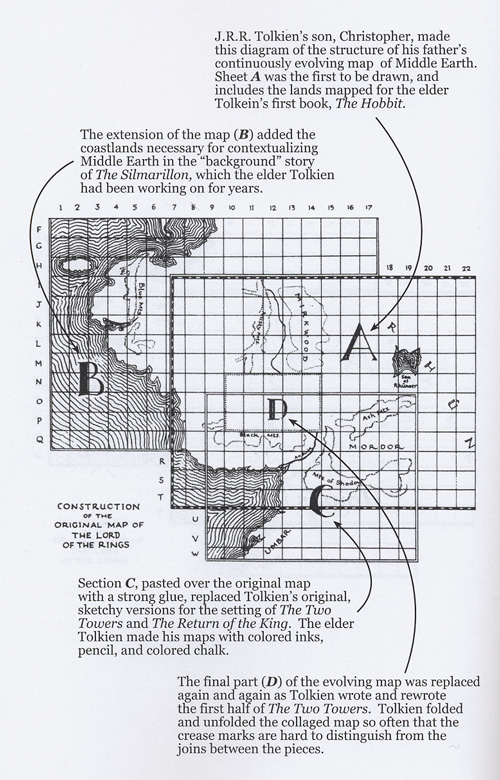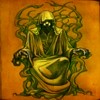The distances given by Tolkien in the texts are sometimes very inaccurate. Tolkien's usage of leagues, furlongs, fathoms, and ells added to the mystique and feeling of history, but also to the bewilderment of the mapmaker. A fathom equals six feet; an ell, 27 to 45 inches; a furlong, 220 yards or one eighth of a mile. These smaller units are relatively unimportant to the cartographer's calculations, but a league — how long is a league? Its distance has varied in different times and countries from 2.4 to 4.6 miles ...
Distances given in leagues in The Lord of the Rings (the only work whose maps included a scale) ranged from 2.9 miles per league (up the Anduin between Pelargir and the landings at Harlond) to 17.5 miles per league (the straight-line distance from Helm's Deep to the Fords of Isen) ... so to establish some common ground for a reliable system of measurement, almost all Middle-earth cartographers seems to agree on the following two principles:
- The 'First Map' is accurate in scale. Grid = 100 miles.
- The appendix on Númenorean Linear Measures in Unfinished Tales, chapter 'The Disaster of the Gladden Fields', gives the correct ratio for converting leagues to miles: 1 league = 3.0 miles.
from Unfinished Tales The Disaster of the Gladden Fields, note 6:
... in those days the only Númenórean roads were the great road linking Gondor and Arnor, through Calenardhon, then north over the Gwathló at Tharbad, and so at last to Fornost; and the East-West Road from the Grey Havens to Imladris. These roads crossed at a point [Bree] west of Amon Sûl (Weathertop), by Númenórean road-measurements three hundred and ninety-two leagues from Osgiliath, and then east to Imladris one hundred and sixteen: five hundred and eight leagues in all.
The FIRST MAP:
A reproduction of this map is shown in History of Middle-earth, Vol VII. Below a commented version of the same map.

NÚMENÓREAN LINEAR MEASURES - Tolkien's precise description of the Gondorians system of measurement:
from Unfinished Tales The Disaster of the Gladden Fields, APPENDIX:
A note associated with the passage in "The Disaster of the Gladden Fields" concerning the different routes from Osgiliath to Imladris (note 6) runs as follows:
Measures of distance are converted as nearly as possible into modern terms. "League" is used because it was the longest measurement of distance: in Númenórean reckoning (which was decimal) five thousand rangar (full paces) made a lár, which was very nearly three of our miles. Lár meant "pause," because except in forced marches a brief halt was usually made after this distance had been covered. The Númenórean ranga was slightly longer than our yard, approximately thirty-eight inches, owing to their great stature. Therefore five thousand rangar would be almost exactly the equivalent of 5280 yards, our "league:" 5277 yards, two feet and four inches, supposing the equivalence to be exact. This cannot be determined, being based on the lengths given in histories of various things and distances that can be compared with those of our time.
Account has to be taken both of the great stature of the Númenóreans (since hands, feet, fingers and paces are likely to be the origin of names of units of length), and also of the variations from these averages or norms in the process of fixing and organizing a measurement system both for daily use and for exact calculations. Thus two rangar was often called "man-high," which at thirty-eight inches gives an average height of six feet four inches; but this was at a later date, when the stature of the Dúnedain appears to have decreased, and also was not intended to be an accurate statement of the observed average of male stature among them, but was an approximate length expressed in the well-known unit ranga. (The ranga is often said to have been the length of the stride, from rear heel to front toe, of a full-grown man marching swiftly but at ease; a full stride "might be well nigh a ranga and a half.").
It is however said of the great people of the past that they were more than a man-high. Elendil was said to be "more than man-high by nearly half a ranga;" but he was accounted the tallest of all the Númenóreans who escape the Downfall [and was indeed generally known as Elendil the Tall]. The Eldar of the Elder Days were also very tall. Galadriel, "the tallest of all the women of the Eldar of whom tales tell," was said to be man-high, but it is noted "according to the measure of the Dúnedain and the men of old," indicating a height of about six feet four inches.
The Rohirrim were generally shorter, for in their far-off ancestry they had been mingled with men of broader and heavier build. Éomer was said to have been tall, of like height with Aragorn; but he with other descendants of King Thengel were taller than the norm of Rohan, deriving this characteristic (together in some cases with darker hair) from Morwen, Thengel's wife, a lady of Gondor of high Númenórean descent.
















